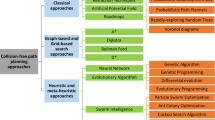Abstract
An energy criterion for choosing the best type of manipulator for a specified task is developed. First, the energy required to perform the robotic task is calculated. Then the lower bound of the mechanical energy consumed by the various kinds of manipulators during their motion, while performing a task, is calculated. Thus, the efficiency of a manipulator for the task is determined. Some examples show that the proper selection of the manipulator configuration can reduce the required energy to a quarter of that of a less suitable one. Once the most suitable manipulator is chosen, the criterion for its most energy efficient motion is developed. The model takes into account the kinematic configuration of the robot, gravitational and other external and internal forces acting on the robot during its operation, and the electric motor driving the robot links. Energy optimization of different paths of motion in joint coordinates is discussed briefly.
Similar content being viewed by others
References
Shiller, Z. and Dubowsky, S., On the optimal control of robotic manipulators with actuator and end effector constraints. Proc. IEEE Second Internat. Symp. Robotics and Automation, St. Louis (1985), pp. 614–620.
Oussama, Khatib, Unified approach for motion and force control of robot manipulators: The operational space formulation, IEEE J. Robotics and Automation RA-3, No. 1, 43–53 (Feb. 1987).
Eppinger, D. and Seering, W.P., On dynamic models of robot force control, IEEE J. Robotics and Automation (Feb. 1986).
Forrest-Barloch, M.G. and Babcock, W.M., Inverse dynamics position control of a compliant manipulator, IEEE J. Robotics and Automation RA-3, No. 1, 75–83 (Feb. 1987).
Sheink, M.A. and Datseris, P., A workspace optimization approach to manipulator linkage design, IEEE J. Robotics and Automation (Feb. 1986).
Paul, R.P., Robot Manipulators, MIT Press, Mass. (1982).
Nof, Shimon Y., Handbook of Industrial Robotics, Wiley, New York (1985).
N-Nagy, F. and Siegler, A., Engineering Foundations of Robotics, Prentice-Hall, New York.
Brady, M., Robot Motion: Planning and Control, MIT Press, Mass. (1982).
Author information
Authors and Affiliations
Rights and permissions
About this article
Cite this article
Maimon, O., Profeta, E. & Singer, S. Energy analysis of robot task motions. J Intell Robot Syst 4, 175–198 (1991). https://doi.org/10.1007/BF00440418
Received:
Accepted:
Issue Date:
DOI: https://doi.org/10.1007/BF00440418




